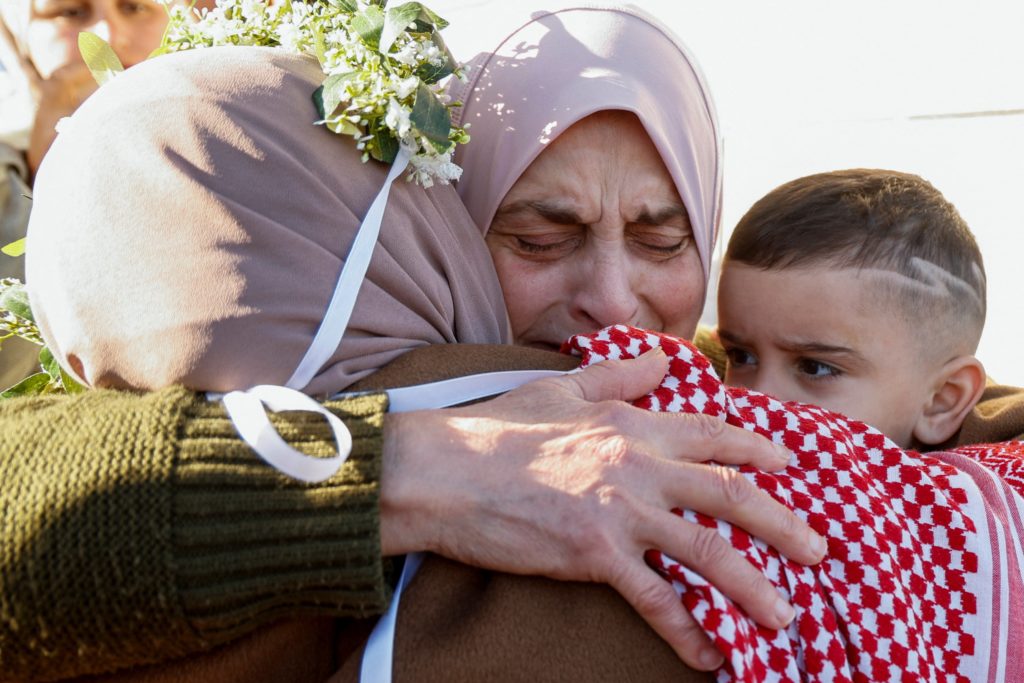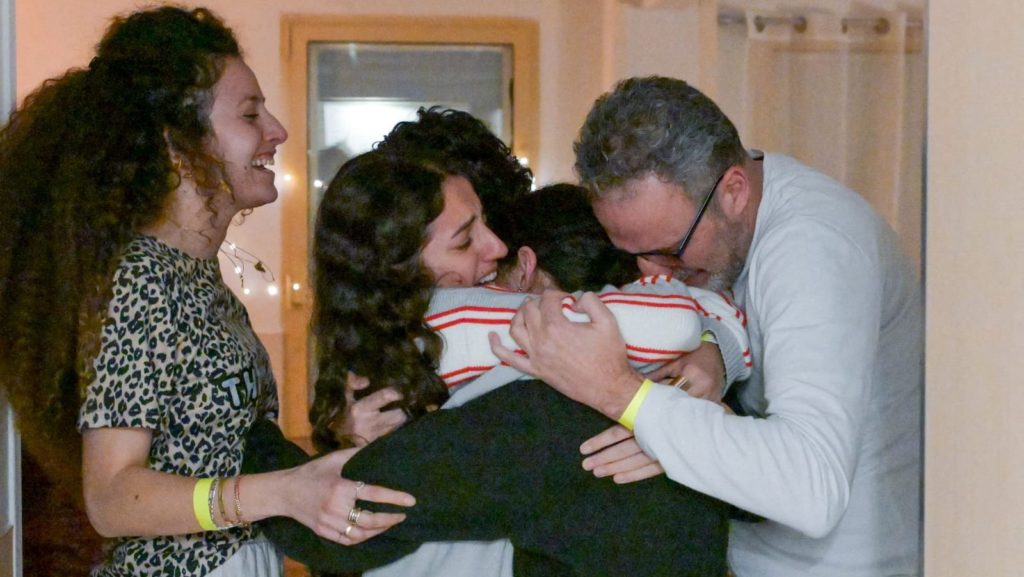Starting at 4 p.m. on Jan. 19, crowds of Israelis arrived at what has become known as Hostages Square in the center of Tel Aviv to support the hostage families and watch the release screened on the giant screen in the square.
They hugged, cried and cheered as they watched the women being transferred from Hamas to Red Cross representatives.
In the West Bank, scenes of joy were delayed but the streets erupted in cheers as the first 90 prisoners, mostly women and teens, freed from Israeli prisons, were brought home in white Red Cross buses after midnight Jan. 20 as in the Gaza Strip first caravans of those displaced by 15-month war attempted return to their homes -- of which scores are flattened -- and first 600 trucks of aid entered the strip.
The first Israelis to be released from Hamas captivity were Emily Damari, 28, and Doron Steinbrecher, 31, both of whom were taken from their homes in Kibbutz Kfar Gaza along the Gaza border in the Oct. 7, 2023, Hamas attack, and Romi Gonen, 24, who was among the 40 people kidnapped from the Nova dance festival that same day. Some 250 people were taken hostage in total on Oct. 7, and 1,200 were killed, according to Israel.
Almost 47,000 Palestinians have been killed in the ensuing war, according to the Hamas Ministry of Health in Gaza, which does not distinguish between civilian and combatant deaths.
Videos released by Israel showed the family of the released hostages breaking out in tears of joy as they privately watched the live broadcast of the release. In one recording Gonen's brother asked his grandmother if she could believe her release was actually happening and the grandmother responded that the belief that Gonen would come home alive was the one thing that had kept her alive.
One TV report showed Damari's friends celebrating ecstatically and singing in her home as they waved flags, with one friend shouting "Emily, come home! We have waited for you, my life!"
Palestinian videos showed a stream of Gazan civilians returning through rubble to their homes in northern Gaza and armed Hamas militants celebrating perched in white pick-up trucks driving through throngs of cheering Palestinians also amid rubble.
The Israeli women appeared gaunt but were able to walk on their own. Videos showed the women being transferred from Hamas hands to the Red Cross representatives surrounded by armed Hamas gunmen and amid a shouting throng of Gaza civilians.
The Red Cross representatives then drove them to the border with Israel where they were met by elite units of the Israel Defense Forces who took them to the initial reception point on the Gaza border area inside Israel where they met with their mothers and underwent initial medical evaluation. They were then transferred by helicopter to hospital where other family members awaited them.
In one released photo, Damari is shown smiling and speaking with her family on a mobile phone as she holds up her bandaged left hand with her two middle fingers apparently missing.
"After 471 days Emily is finally home. I want to thank everyone who never stopped fighting for Emily throughout this horrendous ordeal, and who never stopped saying her name. In Israel, Britain, the United States, and around the world. Thank you for bringing Emily home," said Mandy Damari, mother of British-Israeli Emily Damari in a statement.
She said, "Emily's nightmare in Gaza is over," but "for too many other families the impossible wait continues. Every last hostage must be released."

Pope Francis expressed his gratitude for the announced ceasefire in Gaza in his Jan. 19 Angelus prayer and thanked the mediators for their efforts toward peace and in assisting to arrange the long-awaited ceasefire in Gaza after 15 months of war. The agreement will allow for the slow release of the first group of 33 Israeli hostages over the next six weeks, flow of international aid into Gaza and the release of 90 Palestinian prisoners held by Israel.
"I also thank all the parties involved in this important result. I hope that what has been agreed will be respected immediately by the parties, and that all the hostages may finally return home and embrace their loved ones. I pray a lot for them and for their families. I also hope that humanitarian aid will reach the people of Gaza, who so urgently need it, even faster and in large quantities," he said.
The agreement calls for all the hostages, both alive and dead, to be released in three phases, in exchange for 1,900 Palestinian prisoners. Hamas is still holding 94 captives, with reports varying on how many of them are still alive, which Hamas did not confirm to Israel.
According to the Israelis Hamas is to give the names of the hostages to be released in the following weeks. Among those to be released in the first stage are Americans Keith Siegel and Sagui Dekel-Chen as well as the Bibas family including their now-2-year-old and 5-year-old-son. Some 1,167 of the Palestinians to be released are from Gaza and were detained after Oct. 7, 2023, under emergency laws permitting arrest without charge or trial.
President Joe Biden spoke on Jan. 19 in Charleston, South Carolina, and said"Today the guns in Gaza have gone silent," adding that"this is one of the toughest negotiations I've been part of."
Meanwhile, during a Jan. 19 rally in Washington ahead of his Jan. 20 inauguration, President-elect Donald Trump took credit for the Israel-Hamas ceasefire deal and said that in what was a "beautiful" event, "we achieved an epic ceasefire agreement as a first step toward lasting peace in the Middle East. And this agreement could only have happened as a result of our historic victory in November," Trump said.
In the first phase of the three-phased agreement, fighting will pause for the first 42 days, with Israeli forces withdrawing to a buffer zone from "all" populated areas of Gaza, displaced Palestinians returning home, and increased aid deliveries.
In the second stage, the remaining hostages including men and foreign nationals from Thailand and Tanzania will be freed, more Palestinian prisoners released, and Israel will fully withdraw from Gaza. The Rafah crossing will open for the sick and wounded, though its control is unclear. The third phase, possibly lasting years, will address the exchange of bodies of the remaining hostages who are dead and Gaza's reconstruction.
U.N. Emergency Relief Coordinator Tom Fletcher highlighted the entry of humanitarian aid into Gaza following the ceasefire Jan. 19.
"As the ceasefire entered into force today, humanitarian aid moved into Gaza as part of a prepared surge to increase our support to survivors. More than 630 trucks with humanitarian aid entered Gaza today, with at least 300 of them going to the north," he said.
As joy intertwined with trepidation both in Israel and in the Palestinian territories, Pope Francis said that both Israelis and Palestinians need "clear signs of hope," as he trusted that their political leaders with the help of the international community would yet be able to reach "the right solution" for the two states.
"May everyone be able to say: yes to dialogue, yes to reconciliation, yes to peace. And let us pray for this for dialogue, reconciliation and peace," he said.

